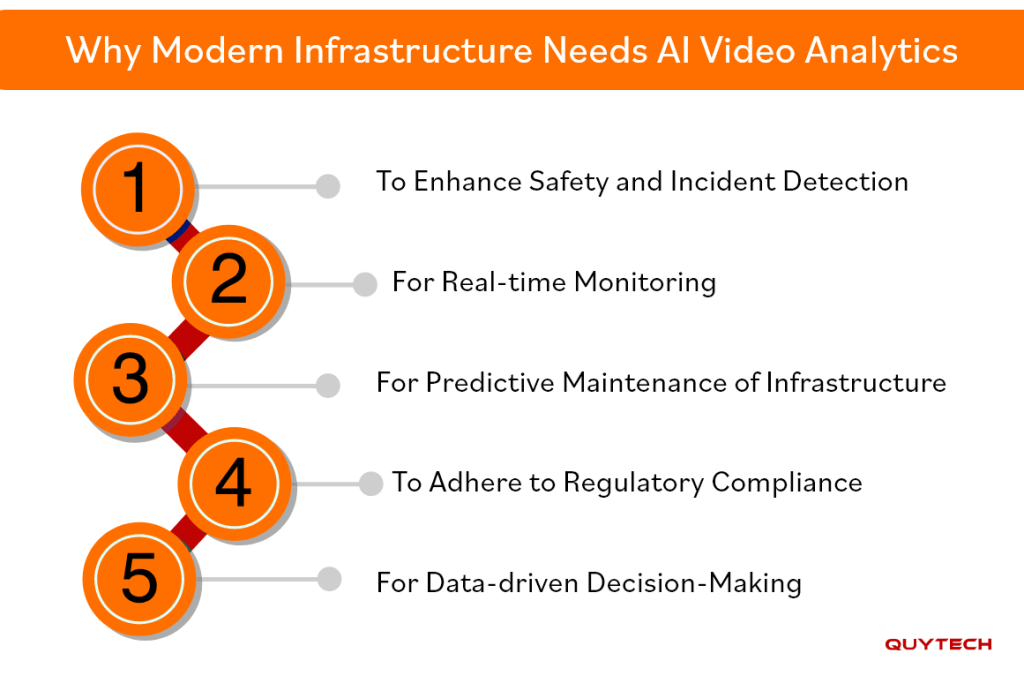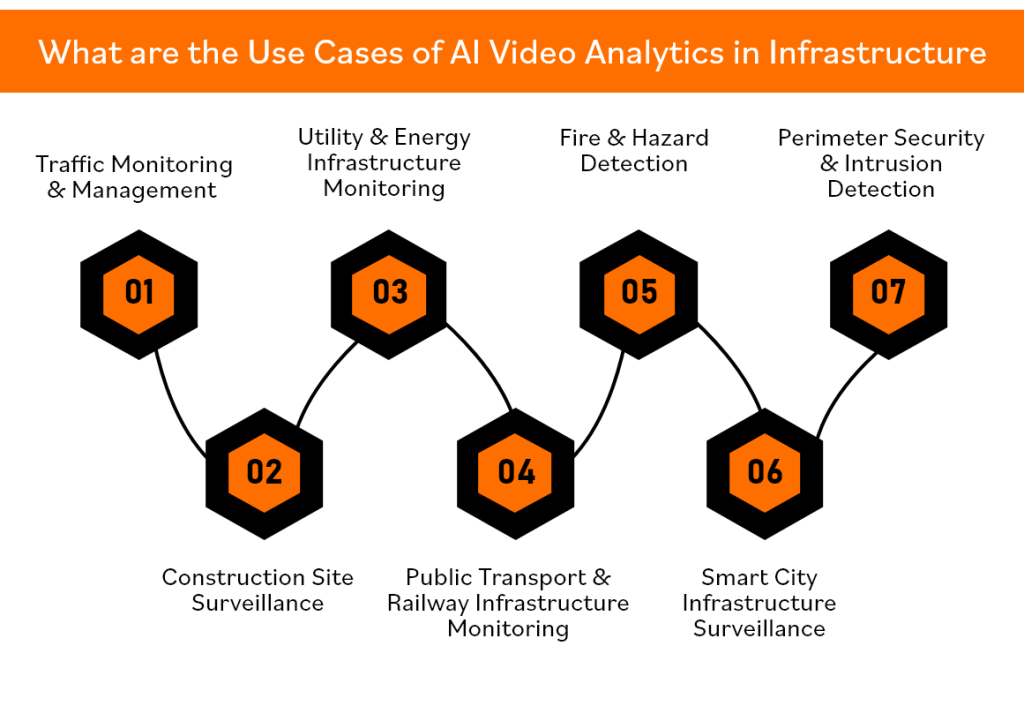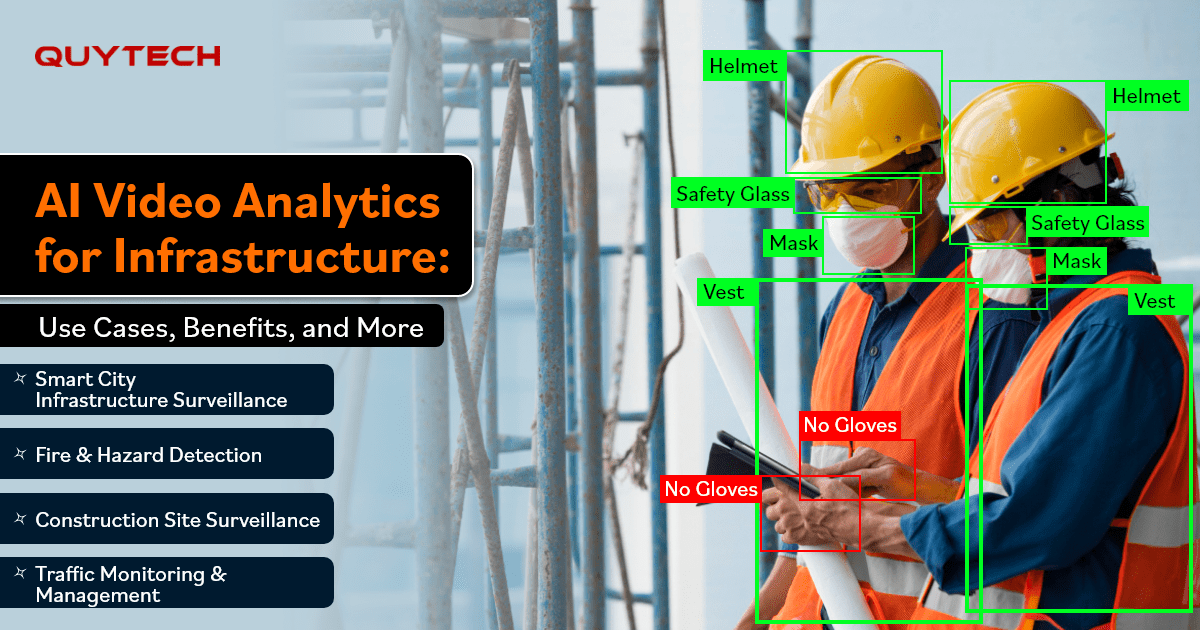With the modernization of infrastructure, cities are becoming smarter, transportation hubs are becoming increasingly complex, and other public facilities are undergoing upgrades. While enhancing convenience and improving safety, the modern infrastructure also brings forth several challenges (complex operations, security, etc.), making it necessary to upgrade traditional surveillance systems with AI-powered video analytics.
Some might have understood the potential of AI video analytics by its name only, while others may want to explore it further. AI video analytics means using artificial intelligence and similar technologies for smarter and real-time surveillance or monitoring of roads, bridges, tunnels, construction sites, railways, and utilities.
Dig deeper into this blog to learn more about AI video analytics for infrastructure. Our experts have covered what AI video analytics is, why it is crucial for efficient infrastructure management, where it can be implemented, and how to implement AI video analytics in infrastructure management.
Without further ado, let’s begin!
What is AI Video Analytics for Infrastructure
As aforementioned, AI video analytics for infrastructure means using artificial intelligence, computer vision, and deep learning to upgrade the security surveillance systems at roads, bridges, construction sites, railways, utilities, tunnels, and other infrastructure.
AI video analytics enable intelligent monitoring by automatically analyzing video feeds from cameras in real-time. It eliminates the need for manually analyzing video footage as it does that in real-time.
Now, the question is, why is this analysis required? The answer is to identify patterns, recognize objects, and detect anomalies at construction sites, in public places, under roads, in tunnels, and similar infrastructures. AI video analytics solutions for infrastructure can even trigger alerts or take actions (in case it is powered by Agentic AI), if required.
Why Modern Infrastructure Needs AI Video Analytics
Operational inefficiencies, delay in responding to critical incidents, high maintenance costs, and safety risks at bridges, power stations, construction sites, or public transport systems may lead to inefficient infrastructure management. Here are some other reasons why you should get an AI video analytics software for infrastructure monitoring.

#1 To Enhance Safety and Incident Detection
Artificial intelligence, when integrated into your infrastructure’s security surveillance system, can detect smoke, fire, dangerous equipment behavior, and workers not wearing safety gear. This can help prevent accidents or breakdowns before they actually occur.
To learn more about this, watch this: AI-powered fire detection system
#2 For Real-time Monitoring
With live monitoring of infrastructure, AI video analytics can ensure no unauthorized entry or access to a construction site. It can also proactively raise an alert for a traffic congestion on the highway. Unlike traditional surveillance systems that can only record video footage and then require hours of manual analysis to review, an AI-powered video monitoring system for infrastructure offers real-time analysis of the feeds.
#3 For Predictive Maintenance of Infrastructure
Artificial intelligence-powered surveillance systems can be installed in an infrastructure to identify early signs of structural stress or equipment failure by analyzing wear and tear. This can prevent costly downtime and the cost of repairing the equipment. Besides, it also ensures the safety of the workers operating that equipment.
Similar Read: How Predictive Analytics Powered by AI is Revolutionizing Decision-Making?
#4 To Adhere to Regulatory Compliance
AI video analytics for infrastructure monitoring can automatically ensure compliance with safety norms. For example, when installed on a highway, it can flag those riders who are not wearing protective gear, i.e., a helmet. Similarly, it can also observe vehicle movement to make sure that they are following the defined limits.
#5 For Data-driven Decision-Making
AI video analytics enables infrastructure management authorities to adopt a proactive approach to minimize risks, enhance safety, and improve return on investment. It ensures smarter and safer environments.
What are the Use Cases of AI Video Analytics in Infrastructure
When it comes to infrastructure monitoring and management, artificial intelligence-powered video analytics can be used in different areas. Let’s check out key use cases of AI video analytics in infrastructure:

#1 Traffic Monitoring and Management
The first use case of AI video analytics in infrastructure is traffic monitoring and management. It can monitor traffic flow, tell the chances of congestion or detect congestion, mark violations, and even help with managing traffic signals smartly. Authorities can get an idea of the road usage in real-time.
Smart cities, highways, toll booths, and urban road networks are perfect places where AI video analytics can be used for traffic monitoring and management.
Explore More: AI for Smart Traffic Management: Reducing Congestion and Accidents
#2 Construction Site Surveillance
Using an AI video analytics solution can enhance construction site surveillance and detect safety violations, unauthorized access to a site, and misuse of equipment. Authorities can verify if the workers at the site are wearing proper protective gear or not. For this, they don’t need to do any manual analysis. The solution will automatically raise an alarm if someone is not wearing safety gear.
Large-scale construction projects and high-risk industrial areas are perfect places where AI video analytics can be used for smart surveillance.
#3 Utility and Energy Infrastructure Monitoring
AI-driven cameras with video analytics capabilities can efficiently and quickly detect anomalies, such as overheating of equipment, people entering a restricted area, chemical or gas leaks, and more. This ensures timely intervention, prevents service disruptions, and avoids the occurrence of accidents.
Power plants, substations, oil rigs, and renewable energy companies are perfect places where AI video analytics can do wonders.
You may want to read: AI in the Energy Sector: How AI Enhances Resource Management and Sustainability
#4 Public Transport and Railway Infrastructure Monitoring
Artificial intelligence-powered video analytics enhances the safety of passengers, helps with crowd management, and ensures platform surveillance. The system can immediately raise an alarm upon detecting an unattended vehicle/bag, people on track, and people attempting to enter restricted areas.
Railway stations, bus terminals, metro stations, and airports can make the most of AI-powered video analytics and surveillance.
Explore More: How to Build AI-Powered Crowd Monitoring Systems? CCTV Security Solution
#5 Fire and Hazard Detection
Detecting smoke, fire, or chemical leaks within a few minutes after they happen can help avoid big accidents. Traditional surveillance depends on human analysis to detect the same and take action. On the other hand, AI-powered video analytics systems for infrastructure can immediately detect the same and trigger an alarm for a faster evacuation and prompt response.
Warehouses, tunnels, parking zones, and industrial areas are perfect places that can benefit from AI video analytics-powered surveillance.
#6 Smart City Infrastructure Surveillance
Implementing AI video analytics systems can efficiently monitor smart city infrastructure and trigger an alarm to the authorities in case of illegal dumping, vandalism, abandoned vehicles, and similar situations. This can help law enforcement agencies and civic authorities enhance safety and security while ensuring a clean environment and surroundings.
City surveillance grids, waste management areas, and public parks are the places where AI video analytics can be implemented.
#7 Perimeter Security and Intrusion Detection
AI video analytics in infrastructure can also be used to detect suspicious behavior, unauthorized entry, and intrusion around infrastructure. This can prevent theft and ensure the complete safety of the people living or working there.
Data centers, airports, water treatment plants, and telecom towers can make the most of artificial intelligence-powered video monitoring and surveillance.
You may like to read: AI-Powered Video Analytics for Public Sector

Benefits of Using AI Video Analytics for Infrastructure
Artificial intelligence-powered video analytics redefines the way infrastructure (roads, bridges, construction buildings, transportation, and more) is monitored and maintained. It enables authorities to make data-backed decisions while minimizing dependence on manual surveillance, which is reactive. Apart from this, below are some of the amazing advantages of integrating AI video analytics in different infrastructure:
- Real-Time Infrastructure Monitoring with Auto-Alerts
Artificial intelligence-enabled video analytics offer real-time monitoring of infrastructure to detect and send alerts in case of unusual events or situations. This enables authorities to take quick action.
- Enhanced Safety and Risk Prevention
Video analytics powered by artificial intelligence can efficiently identify unsafe behavior in construction sites and on roads. For instance, it triggers an alert upon identifying that a worker is not wearing proper safety gear. This prevents accidents.
- Operational Efficiency and Cost Reduction
The implementation of artificial intelligence-powered video analytics eliminates the need for manual surveillance, which requires a significant amount of time and also prone to errors. Automation of surveillance and analysis improves operational efficiency and minimizes cost.
- Data-Driven Decision-Making
AI video analytics for infrastructure provides actionable insights by continuously analyzing visual data. These insights could be about trends and potential bottlenecks or problems that may occur; authorities can use them to make informed decisions.
- Predictive Maintenance of Assets
With video analytics powered by artificial intelligence, monitoring infrastructure components (wear and tear on equipment, stress on structures, chemical or gas leaks, etc.) becomes easier and automated. Timely alerts about these components can prevent the chances of breakdowns and extend the life of the assets.
- Automated Reporting
By integrating Artificial Intelligence video analytics in infrastructure, construction companies and authorities can save time and effort required for generating compliance reports and incident summaries.
Which Technologies are Used to Integrate AI-powered Video Analytics in Infrastructure
Implementing AI video analytics in infrastructure requires multiple technologies to work together to serve different use cases, including the ones that have been covered in the earlier section of this blog. Let’s take a brief look at these technologies:
- Computer Vision: Enables the AI video analytics software or solution capable of interpreting and comprehending visual data from cameras for object or movement detection and pattern identification. The technology does this in real-time.
- Edge AI: As the name suggests, Edge AI processes data (visual data) right where it is generated, i.e., surveillance systems or CCTV cameras. This saves time while reducing latency and creating room for faster decision-making.
- Deep Learning: Using algorithms like CNNs, deep learning makes the AI video analytics system for infrastructure capable of detecting anomalies, recognizing behavior, and making a difference between objects, vehicles, machines, humans, etc. This helps in the accuracy of the results that the system generates.
- Machine Learning: With ML, the AI video analytics systems can self-train for improvement. The same technology takes charge of making the system capable of analyzing historical data, recognizing patterns, and predicting future events for proactive decision-making.
- IoT: The Internet of Things technology is equipped with sensors that capture real-time visual and environmental data and then feed the same to the AI video analytics systems to generate output.
How to Implement AI Video Analytics in Infrastructure
Integrating artificial intelligence-powered video surveillance in infrastructure requires in-depth expertise in AI, computer vision, Edge AI, and other similar technologies. It also requires setting up a full-fledged development team or hire AI developers. You can also outsource your project to a trusted AI video analytics development company. In case, if you wish to integrate it on your own, follow these steps:
Step 1: Define the Objective
Identify the problem you want to solve or particular area you want to improve. It could be anything from optimizing traffic flow to ensuring workers’ safety at a site.
Step 2: Analyze Existing Infrastructure and Surveillance Systems
Thorough audit your current surveillance system, like CCTV cameras, bandwidth, and more to decide with which an AI video analytics system will work, what angles should it cover, and type of outcome and accuracy levels you expect.
Step 3: Design and Develop AI Video Analytics Solution
This involves building the architecture of the AI video analytics system and developing it using the right tech stack to serve the required use case or purpose. Choose capabilities like edge processing, real-time alerts, and easy integration with your systems.
Step 4: Train and Test AI Models
The AI models that are integrated in your AI video analytics solution should be trained on relevant and clean data. Make the most of historical footage and live video feeds to train the model for detecting anomalies and identifying patterns and breaches. Once trained, test the model for performance and accuracy in outputs.
Step 5: Integrate with Existing Surveillance Infrastructure
Now integrate the developed AI vide analytics solution with your camera network, control room systems, and other infrastructure management systems. Define the medium with which you would like to receive alerts in case of critical events. Run testing again to ensure everything works as expected.
Step 6: Monitor and Fine-Tune
Continuously monitor the system’s performance and make changes to the sensitivity levels, if required. Keep on training models with new data to ensure accurate outputs and long-term reliability.
You might be interested in: Intelligent Video Monitoring Systems Development: A Complete Guide
Real-World Example of Artificial Intelligence Video Analytics in Infrastructure
Let’s check out AI video analytics in infrastructure examples to know about the companies and governments that have already implemented AI video analytics for intelligence surveillance of roads, bridges, tunnels, transportation, and other infrastructure.
Larsen & Turbo

This leading infrastructure and construction company has implemented AI-powered video analytics to monitor workers’ safety, PPE compliance, and usage of equipment in their large-scale construction sites. This helps the company to minimize or prevent on-site incidents.
City of Chicago

To achieve the goal of smart traffic management, Chicago’s Department of Transportation has upgraded its surveillance cameras with video analytics powered by AI. The system is capable of optimizing traffic light patterns, identifying congestion, and ensuring smooth pedestrian flow.
Changi Airport

Singapore’s Changi airport relies upon AI video analytics to facilitate real-time monitoring of passengers’ movement, detect unattended baggage, and predict maintenance requirements at its terminals. It upgrades the airport security system.
How Quytech Can Help Implement AI Video Analytics in Infrastructure
Quytech is a well-known and the most trusted AI video analytics solutions development company that can build such a solution from zero to one or integrate the same in your existing infrastructure monitoring system. We have dedicated AI professionals with expertise in computer vision, video analytics, Edge AI, and other technologies required to facilitate intelligent infrastructure surveillance and management at construction sites, highways, public places, and utilities.
With over 14+ years of experience in the industry and over 7 years of experience dedicatedly in AI video analytics, we have successfully developed and delivered high-performance video analytics solutions for crowd monitoring, queue detection, suspicious behavior monitoring, fall detection, and others.
We focus on customization, scalability, and also ensure AI models are well-trained to make the most of video data and deliver accurate outputs and actionable insights.
Conclusion
Artificial video analytics has been aggressively used in smart cities, transportation hubs, construction sites, and other infrastructure across the world. Reason? The real-time monitoring and alerts it delivers to detect safety breaches, track assets, monitor crowd movements, predict equipment failures, and more.
In the modern infrastructure, AI video analytics is no less than a boon that enhances safety, enables authorities to respond immediately, and ensures better infrastructure management. Read this blog to know inside-out about AI video analytics for infrastructure. If you wish to implement the same in your existing infrastructure surveillance systems, connect with an experienced and trusted technology partner.
FAQs
With AI video analytics implementation in infrastructure, you might encounter challenges like inability to scale, lack of data privacy, not meeting hardware requirements, and environmental limitations.
Definitely. AI video analytics can be seamlessly integrated into new infrastructure and also upgrade existing security surveillance systems, i.e., IP cameras and CCTV cameras.
Yes. AI video analytics leverages technologies like Edge AI to monitor and process video feeds in real-time. The system can detect anomalies and trigger immediate alerts for real-time decision-making or take prompt action.
When you choose a reliable partner for an AI video analytics system in any infrastructure, they ensure complete data security by implementing robust security protocols and data encryption and access control methods.
The cost and time both depends on the type of infrastructure it is being deployed on, the complexity of the data, and a few other factors.


